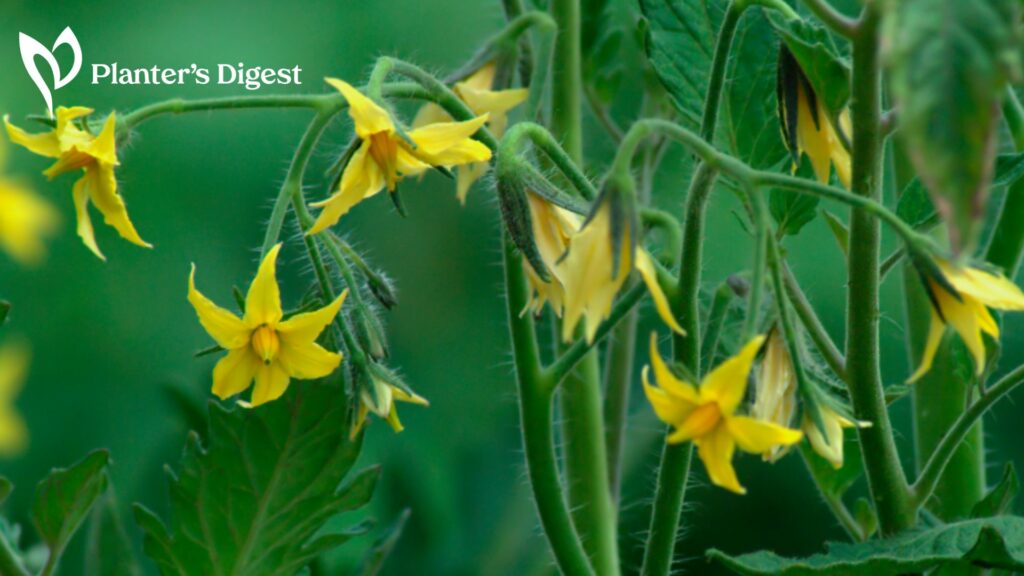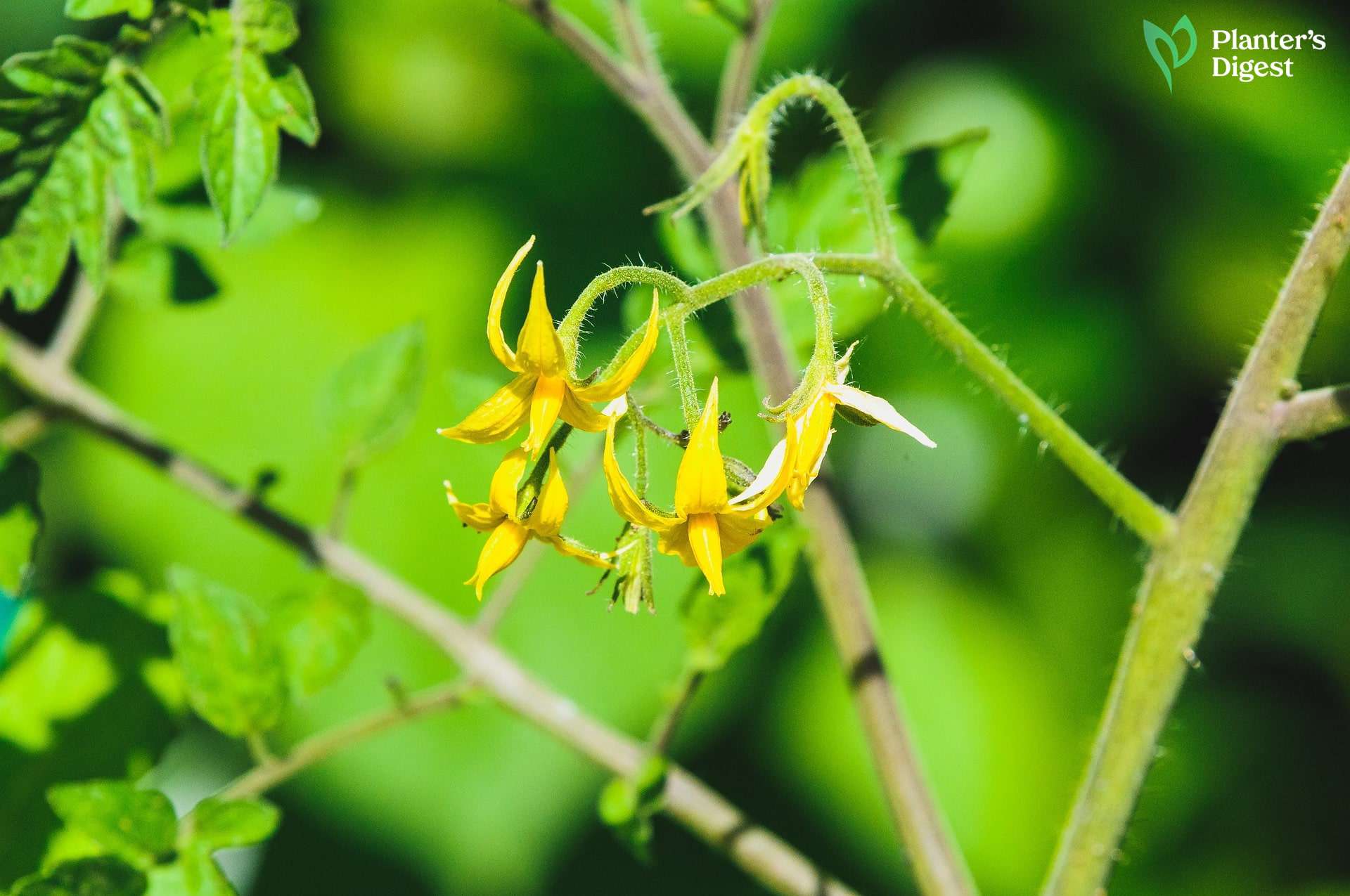
Patience is vital in gardening. But how do you know you’re not waiting in vain for your tomato to flower?
If you’ve waited a month or more and no yellow flower emerges from your tomato plant, then that’s your cue to start looking at other factors affecting your plant’s development.
This article will help you trace why and how to fix your tomato plant that won’t flower.
Why is my tomato plant not flowering?

There are a few reasons why a tomato plant is not flowering. Let’s discuss each culprit one by one.
1. Disease and Pest Damage

| How To Fix: | Keep the leaves dry and apply fungicide regularly. |
Tomatoes need to use all of their energy to produce vibrant yellow flowers and red fruits. They need help to successfully do this with diseases and pests competing with the energy.
First, you should look for signs of pest infestation or diseases on its leaves, stems, and other parts.
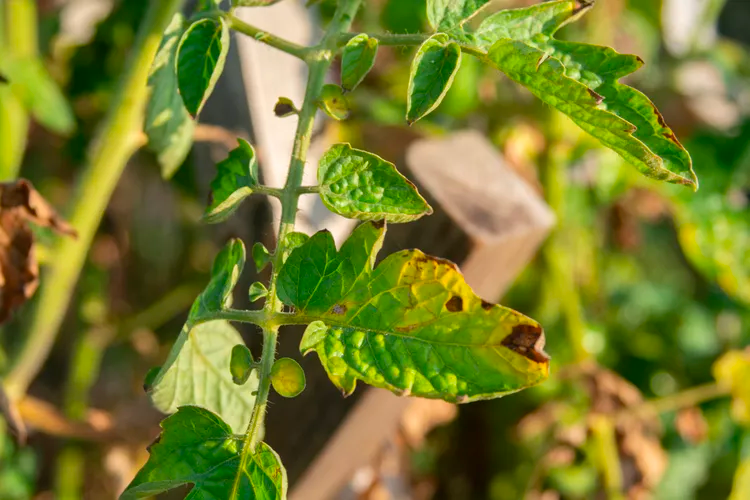
For instance, tomato plants produce less energy through photosynthesis when they have few leaves or their foliage has bacterial spots, wilts, or lesions.
Some diseases like blight and Septoria leaf spot affect the leaf production and health of the tomato plant. Pests like aphids and caterpillars also cause defoliation to the plant.
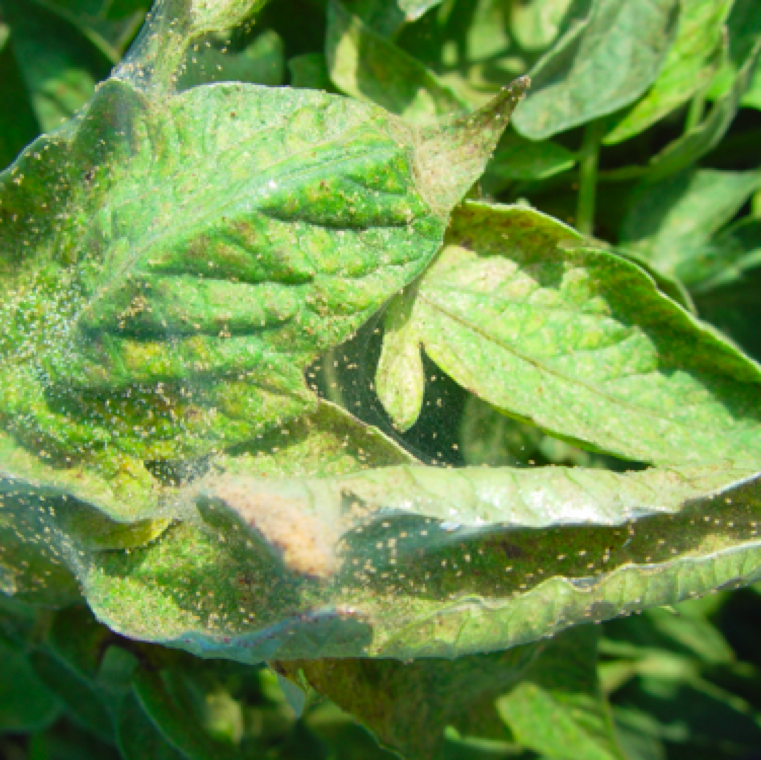
If you notice silk strands near the closed flower bud, these are signs of spider mite infestation. Look also underneath the leaves if there are tiny black or red arachnids.
Most tomato plant diseases start from wet leaves that become a breeding ground for bacteria and fungi. The best way to prevent their proliferation is to keep the leaves dry, especially the low-lying ones.
You should also use fungicides at least once a week to prevent pests from feeding on your tomato plant.
| Planter’s Tips 1. For Spider Mite Infestation Cut the trusses of the plant. Wait for new side shoots to develop within 1 to 2 weeks so you’ll have new flowering trusses. 2. For Tomato Pests Once you know the plant disease’s primary cause, treat them immediately to prevent spreading. Most tomato pests can be removed by hand or through an oil-based solution like neem oil. 3. For Tomato Plants in General The best solution is still prevention. You won’t have to worry about any disease or pest when you keep your plant healthy by watering them and practicing good plant hygiene. |
2. Nutritional Imbalance

| How To Fix: | Introduce the right fertilizer at the right time. |
Plants need all essential nutrients to develop healthily. A little too much or less of one element will definitely disrupt the tomato plant’s growing process.
Here are the consequences of an imbalance of the following nutrients:
- Calcium
When the tomato plant lacks calcium, it develops a condition called “blossom end rot.” The lack of color and inward curling of its leaves shows signs of a lack of calcium. - Nitrogen
Nitrogen is essential for a plant’s growth. This element helps boost leaf and stem growth in a tomato plant.
However, too much nitrogen will focus the plant’s energy on its leaves and stem, leaving no energy left to produce flowers. Having excess nitrogen also makes the tomato plant prone to pests and diseases.
- Magnesium
You’ll know the plant lacks magnesium when you see discoloration on the veins of its leaves. These leaves also turn yellow and brown as the plant undergoes a mottled appearance called “inter-vein chlorosis.” - Potassium
When the tomato plant lacks potassium, it does not develop flowers and fruits. Its leaves, on the other hand, turn brown and roll inwards.
The only way to address this problem is to introduce the right fertilizer at the right time.
Nitrogen-rich fertilizers are advisable for tomato plants from germination until they develop their stems and leaves.
Once the tomato plant matures, potassium and phosphorus-rich fertilizers should be used to encourage the plant to flower and produce its fruits.
3. Sterile Seeds
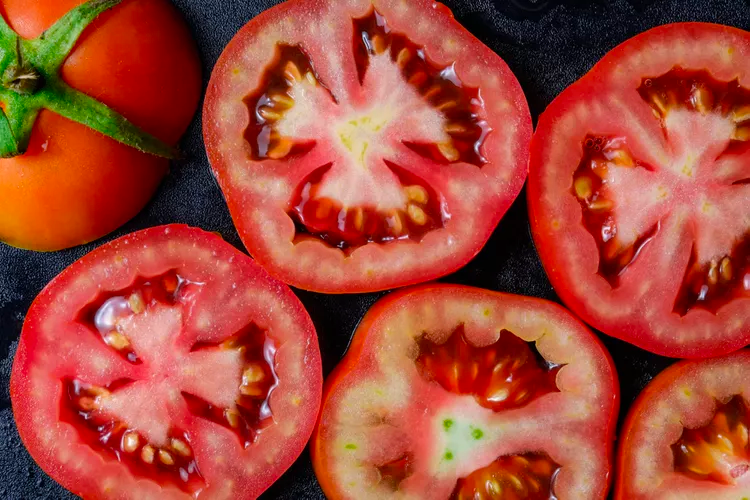
| How To Fix: | Ferment the tomato seeds. |
The source of your tomato seeds can also affect their flowering and fruit-producing capabilities.
If your tomato seeds are from the market, then there’s an assurance that they’re fertile seeds. These have a high chance of flowering when tended to correctly.
If you bought bull tomatoes or planted seeds from a sliced tomato in the soil, you’d most likely get a sterile plant that’s unable to produce flowers and tomatoes.
But this doesn’t mean the tomato seeds harvested from the fruits are useless. You’re probably missing one important step – fermentation.
Unlike other plants whose seeds can be replanted in the soil immediately, the tomato seed is covered with a gel-like sack containing inhibitors preventing the seeds from sprouting inside the tomato.
The best way to remove this sack is to let the seed rot and ferment. Fermenting the tomato seeds will remove the gel-like sack containing inhibitors that prevent the seeds from sprouting and also help kill fungal diseases.
Here are steps on how you can ferment your tomato seeds.
| Difficulty | Easy ●○○○○ |
| Duration | 1 to 2 hours for preparation 2 to 4 days for fermentation |
| Things You Need | • Ripe tomatoes • KnifeSpoon • Water • Paper towel • Paper plant • Sealable bag • Colander • Can or jar • Mixing Bowl |
| How To Do 1. Slice the ripe tomato in half and scoop the seeds into a bowl or jar. 2. Add a cup of water to separate the seeds from the tomato pulp. 3. Cover the bowl or jar with a paper towel. 4. Wait for 2 to 4 days for the seeds to ferment. 5. Check the bowl or jar daily until bubbles form in the mixture or the tomato pulp is covered in mold. At this point, you should already see the seeds settling at the bottom of the jar with the mold on top of them. 6. Strain the mixture using a colander to rinse off the pulp and mold away from the seeds. 7. Dry the tomato seeds on a paper plate and place them in a warm location to dry out. 8. Once the seeds are completely dried out, place them in a sealable bag for storage. |
4. Lack of Pollination

| How To Fix: | Hand-pollinate the tomatoes. |
Tomatoes can be pollinated by air, wind, or bees. They need to get pollinated to produce flowers and fruits.
But if you’ve been waiting for a long time and the blossom drops, you should hand-pollinate the tomato plant. This involves tapping the flowers to help them release the pollen and begin the tomato plant’s flowering process.
| Planter’s Tips: • A warm sunny midday with low humidity is the best time to hand-pollinate tomatoes. • Tap behind the flowers using your finger, pencil, or toothbrush until the pollen is released. • Use a cotton swab to rub the pollen directly to the end of the flower’s stigma. • Repeat hand pollination every 2 to 3 days to make sure pollination occurs, and the fruiting will follow. |
5. Dehydration
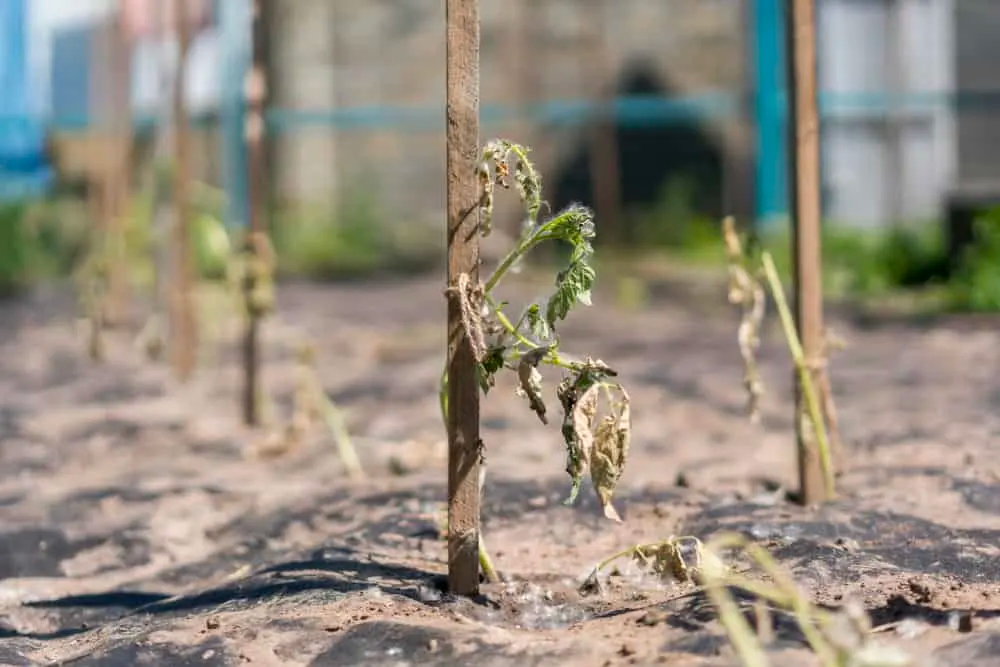
| How To Fix: | Keep tomato plants properly hydrated. |
Without enough water, the tomato plant cannot sustain the energy needed for fruit production.
Remember: tomato plants need 1 to 1.5 inches of water per square foot of soil every week.
Too little water causes poor flower and fruit development in tomato plants. Should it produce blossoms, they tend to be few and will later on drop.
| Planter’s Tips: • If the tomato plant covers 3 to 4 square feet, it will need 3 to 4 gallons per week. • Water tomato plants early in the morning. During summer, water tomato plants twice a day to prevent dehydration. |
6. High Humidity
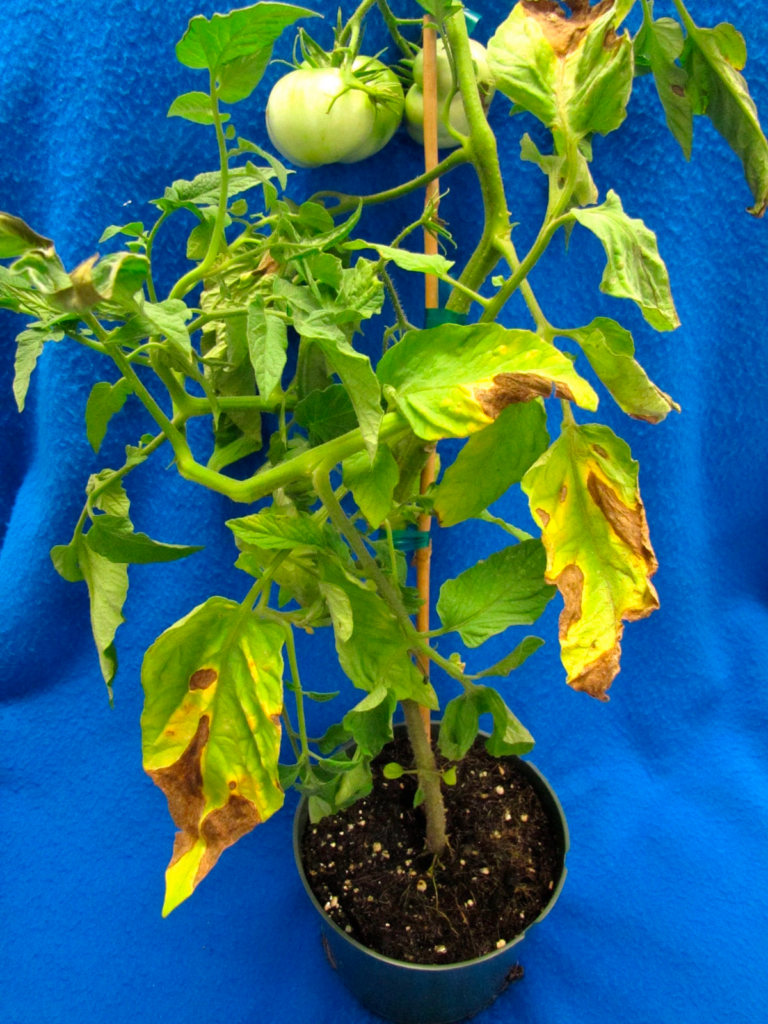
| How To Fix: | Provide adequate spacing and prune low-lying leaves. |
Tomato plants need a relative humidity between 65% and 85%.
Any higher level will cause the pollen to stick to the flower’s stamen, unable to fertilize the pistil and produce fruit. High humidity can even glue tomato flowers together and cause them to rot.
That said, it’s important to ensure adequate ventilation around the tomato plant. A space of 2 to 3 feet apart from the other plants and pruning the low-lying leaves will help facilitate proper airflow.
8. Improper Pruning
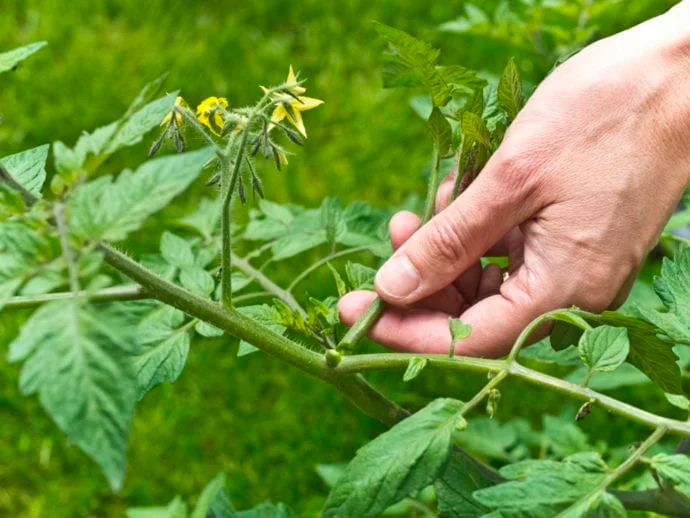
| How To Fix: | Prune the right way. |
Pruning is an essential part of growing tomato plants. It helps the plant direct its energy to producing flowers and fruit and even protects it from bacterial and fungal diseases.
But to achieve these results, you have to do it the right way. Otherwise, cutting the wrong trusses will lead to the tomato plant, not flowering.
That’s because if you allow side shoots to grow or cut the horizontal trusses, you remove the flowering material of the plant and waste its flower-producing energy.
| Planter’s Tips: 1. For bush-type tomatoes: Remove only excess leaves that can cause a build-up of humidity within the plant. 2. For vine tomatoes: Prune out any side shoots that grow from nodes to reduce humidity. |
9. Extreme Temperatures
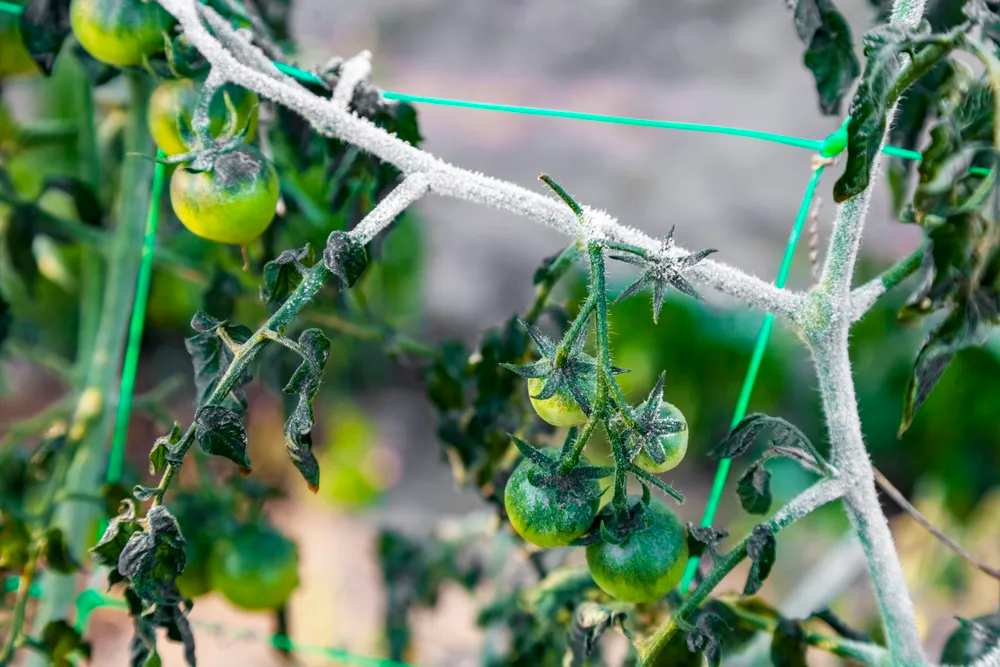
| How To Fix: | Make sure tomato plants are located in an area with the required temperature and that they get 6 to 8 hours of full sun every day. |
Tomatoes love warm weather ranging from 65 to 75°F (18 to 23°C).
You should also consider the temperature of the area where the tomato plant is placed. Too much or too little exposure to the required temperature can cause injuries to the tomato plant.
Extremely cold weather destroys flower buds or partially-opened flowers of the tomato plant.
Also, anything above 80°F (26°C) will cause the plant to stop flowering and producing fruits. Plants use this self-preservation mechanism to save water and energy to keep themselves alive.
| Planter’s Tips: • Move the tomato plant to a cooler spot and away from the scorching sun in times of heat waves. • Water your tomato plant twice daily to limit the potential damage of the heat spells. • Relocate the tomato plant where it will get access to 6 to 8 hours of full sun. • Use grow lights to speed up the flowering process of tomatoes grown indoors or in greenhouses. |
10. Unsuitable Tomato Variety

| How To Fix: | Plant indeterminate tomato varieties. |
If you have determinate tomatoes, this means that they produce their fruits at one specific time in a season.
So if you’ve missed your chance, you can change to a high-yielding indeterminate tomato variety, which produces fruits throughout the season and ensures higher produce.
How can I make my tomato plants produce flowers?
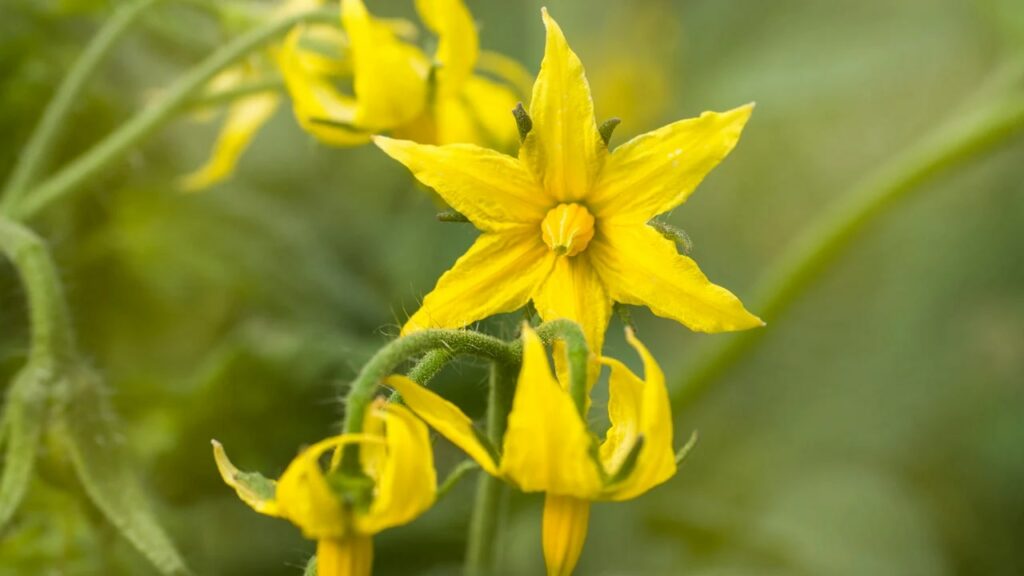
1. Plant indeterminate tomato varieties.

If you want to ensure that your tomato plant will flower and produce fruits regularly, we recommend you plant indeterminate tomato plant varieties.
These indeterminate tomato plants tend to produce fruits all throughout the season, so choosing them will offer you higher chances of getting tomato produce.
You should also choose the suitable tomato variety that suits your garden’s climate and environment. For instance, there’s the Early Resilience tomato, a disease-resistant variety of the plant.
2. Provide enough air and sunlight to the tomato plant.
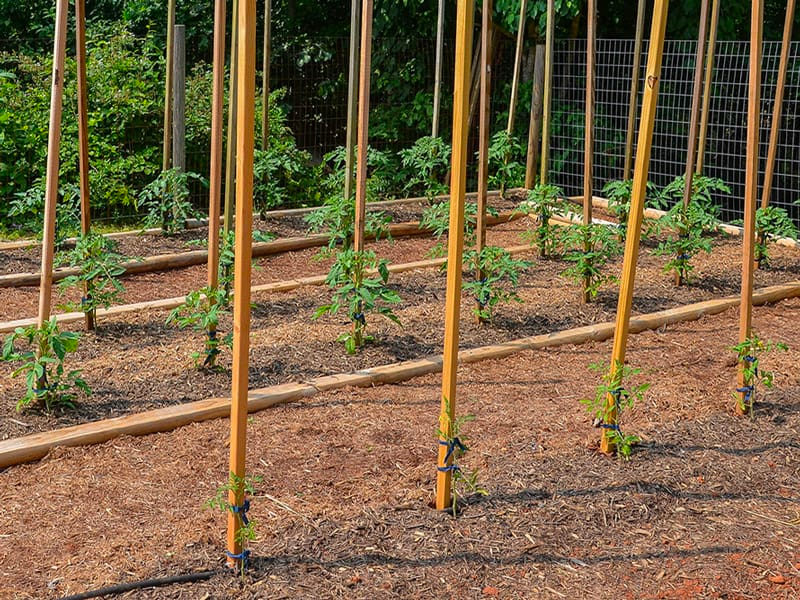
Make sure that the tomato plants are not too close together and that there’s enough wind to self-pollinate.
Ideally, they should be planted at least 3 inches apart. This is ample space, so the plants have no competition over nutrients.
3. Introduce the right fertilizer at the right time.
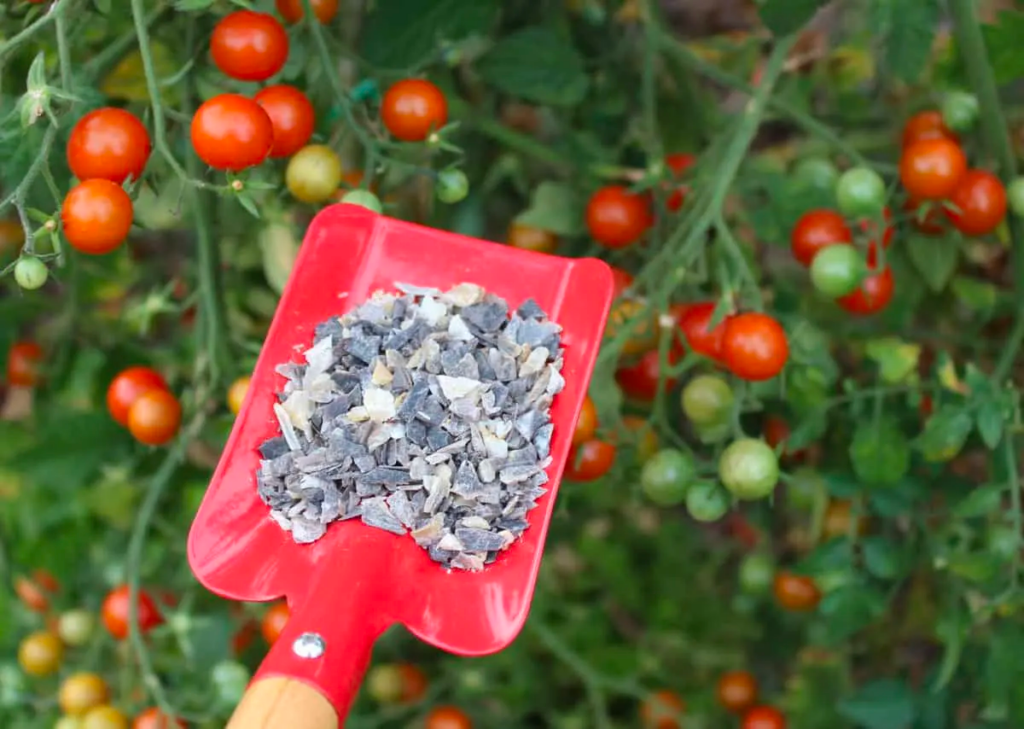
You should introduce the proper nutrients from fertilizers to the tomato plant at the right time.
During its growing season, you should introduce nitrogen-rich fertilizers to help grow leaf and stem.
But after the plant matures, add phosphorus and potassium-rich fertilizer to encourage the plant to flower and produce red tomatoes.
Tomatoes grow best in slightly acidic or neutral soil with a pH of 7. You can add leaves or compost to prevent flowering problems for the tomato plant.
To help combat drastic temperature changes, you can add mulch to retain moisture in the soil.
You can simply use grass clippings, straw, or compost and place them at the bottom of the tomato plant. Mulch will also help prevent any weed growth in your plant.
4. Apply drip irrigation to the plant.
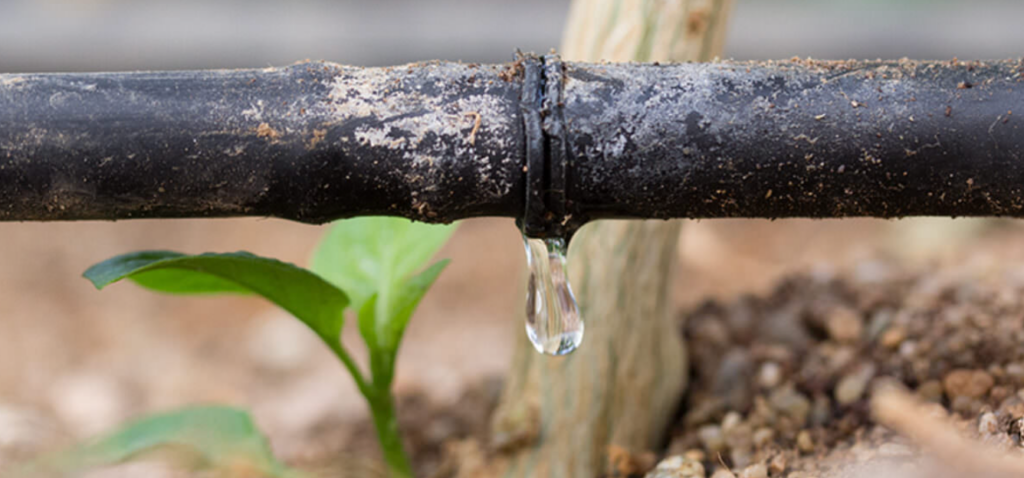
Applying the correct watering method in the same amount daily is a simple yet critical element in keeping a plant healthy and disease-free.
Drip irrigation is the most efficient way of watering a tomato plant. This process involves placing tubes with emitters alongside the plants.
These emitters will slowly release water into the soil at the root zone. Through drip irrigation, the moisture levels are kept at an optimal range.
Overhead watering is unsuitable for tomato plants because it leaves water on the leaves, making it a spreading ground for plant diseases.
Irregular watering increases the chances of leggy plants and fewer fruit-bearing trusses and even causes the tomatoes to split.
5. Prune the tomato plant regularly and properly.

Pruning helps the plant focus its energy on flower and fruit production than developing leaves and stems. It also helps increase tomato yields and extends the harvest season.
If you have bush-type tomatoes, do not prune them except to remove excess leaves that can cause a build-up of humidity within the plant.
On the other hand, you can prune out any side shoots that grow from nodes for vine tomatoes. This reduces humidity, which helps create a more open shape where your tomato plant can direct energy into developing its flowering stems.
6. Use Epsom salt to enhance plant growth.
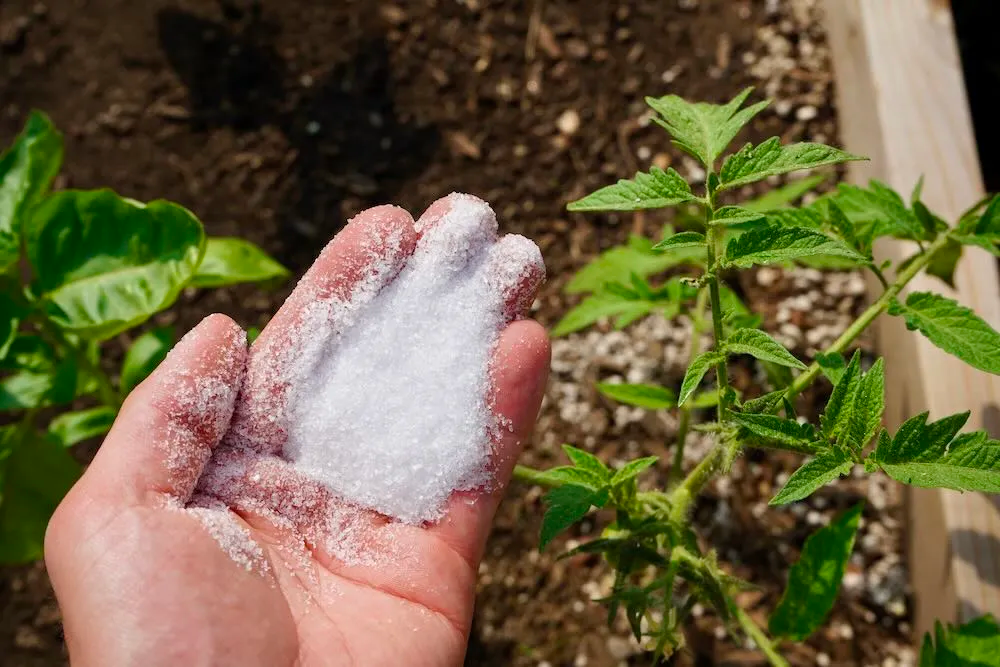
For starters, Epsom is not real salt. It’s actually a water-soluble crystal that contains sulfur and magnesium.
Epsom salt improves seed germination, and plant growth, ensuring the bearing of flowers and fruits of your tomato plant.
You can apply one tablespoon of Epsom salt per foot of the plant height. Do this once every two weeks in its growing season.
Should you transplant the seed, you can also add 1 or 2 tablespoons of Epsom at the bottom of the furrow.
When the tomato plant starts to bloom, adding ½ cup of Epsom salt to the soil will help boost flowering.
FAQs
Tomato flowers have yellow petals and fluffy green sepals. It forms green buds that slowly expand into a star-shaped flower with a long-spiked cone in the middle.
Tomato plants must bloom yellow flowers to produce juicy plump red tomatoes.
After planting, it takes 4 to 8 weeks for a tomato plant to flower. Its vines have grown between 12 to 18 inches tall by this time.
It is highly recommended to remove diseased tomato plants right away. This will prevent disease and infestation transmission to its neighboring plants.
Potassium and phosphorus-rich fertilizers are the best choices in encouraging plants to flower.




